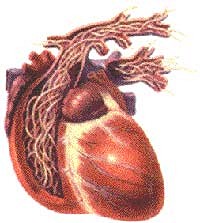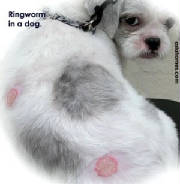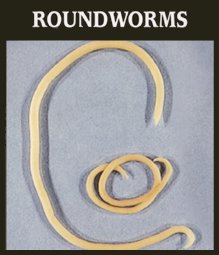|
INTERNAL PARASITES
COCCIDIA - Caused by a group of protozoan parasites. It is very
common in dogs. 30-50% of puppies carry coccidia. Signs of coccidia are: diarrhea, loss of appetite, vomiting, failure to
thrive, and blood in the stool. A puppy coming from a breeder having coccidia is not an indication of poor breeding practices
or an unclean environment. It can be pick up almost anywhere. Coccidia is spread through ingestion of stool of infected dogs,
cats, rabbits, squirrels, horses, cattle, sheep, goats, chickens, mice and other birds. This ingestion can be as little as
walking through infect stool and then licking their paws, to put right eating of infected stool. Coccidia can be detected
by the usual fecal flotation tests that can be preformed by your vet. Coccidia can be easily treated by the use of ALBON which
you can get through your vet or through Revival. Albon prohibits the growth of coccidia that way the dogs immune system can
take over and fight the infection. It can be very dehydrating. I highly recommend a product called CORRID. This product actually
kills the Coccidia and seems to be more gentle on the dogs system than the ALBON. This is a powder solution that is put into
the drinking water of your pets to treat and prevent Coccidia. I have found this product available at Cal Ranch stores or
IF A stores. It can also be purchased through Revival. There is also a liquid form of the CORRID product. To use the powder
CORRID use 1 tsp per gallon of fresh water. 30 mls per gallon fresh water for the liquid form. For preventive use for 21 days
in a row. For treatment use for 5 days in a row.
For more information on coccidia please visit: http://www.peteducation.com
GIARDIA - are one celled organisms that live in the intestines of
dogs and cats. Infection with giardia is common but the disease is rare. Not much is know about the organism and its life
cycle at this time. A dog becomes infected by ingesting the cyst form of the the parasite. It is passed in the feces and can
contaminate a dogs food and water and his environment. Humans can also get giardia but it is unknown if a dog with giardia
can infect a human. Symptoms of giardia are usually not seen. Usually if a puppy is effected you will see diarrhea. Usually
this diarrhea will have a bad odor, be pale, and look greasy. This disease prevents the dog from absorbing nutrients properly
and damages the intestinal lining and hinders digestion. There are stool tests that can check for giardia. Giardia is usually
treated by giving PANACUR. This can be obtained through your vet or Revival. There are also a few other drugs out there that
will treat giardia. These have to be obtained through your vet.
For more information on giardia please visit: http://www.peteducation.com

HEARTWORM - Heartworm
are caused by the bite of an infected mosquito. They carry the larvae of the heartworm. The Larvae can live in the blood stream
of a dog for up to 2 years. Heartworm can cause irreversible damage to the heart by clogging the chambers of the heart and
the pulmonary artery leading to low blood flow and inevitable death. In severe cases the worms can block the vena cava that
brings blood to the right side of the heart causing the blood to back up and enlarge the liver causing serious damage.
Signs of heartworm include: decreased appetite, lost of weight and lethargy.
First signs of heartworm is often a cough. There are several blood tests that can confirm the diagnosis of heartworm.
Once again Ivermec is an effective preventitive against heartworm. Given in
a shot or orally once a month. Remember this is a preventitive and not a cure. In cases where a dog has heartworms more drastic
drugs are give often containing arsenic to kill the adult worms.
For more information on heartworm please go to http://www.peteducation.com
 HOOKWORMS - are the most common internal parasites of dogs and cats. They can cause severe
disease including anemia and diarrhea. You may see pale gums, lethargy in the animal from blood loss, black tarry stools,
and dry dull coat. There are various types of hook worms. These worms can be transmitted in several ways. Worms can bore through
the skin, can be ingested, or can be passed from mother to puppies through the uterus or milk. Treatment can be done in various
forms. Liquid or paste wormers except piperazine are effective. I recommend using either liquid or paste Pyrantel Pamoate
or once again using Ivermec. There are also other over the counter wormers that you can obtain virtually anywhere.
For more information on Hookworms please visit: http://www.peteducation.com

RINGWORM - Contrary to popular belief, ringworm is not a worm but
actually a fungus. It can infect cats, dogs and humans. Ringworm is transmitted by direct contact or with an item that is
contaminated with spores. Symptoms are very specific including a small round, hairless lesion. The lesion will have scaly
skin in the center and small pustules. This lesion can be sore and itchy. It can commonly be misdiagnosed as mange. Some cases
will spread to the face and nose and look like an autoimmune disease. Lesion left alone will heal on their own in 4 months.
There are topical anti fungal creams that can be put on the lesions to help speed the process and ease pain and itching. Anti
fungal shampoos and dips can also be used.
For more information on ringworm please visit: http://www.peteducation.com

ROUNDWORMS - are very common internal parasites infecting the digestive system of dogs
and cats. Most puppies are infested with roundworms. These worms can be transmitted in several ways also. Ingestion of eggs,
ingestion of larvae, Ingestion through mothers milk and transportation through the uterus. These worms can also inhibit nutrient
absorption and damage of the intestinal lining. Most of the time you wont see any indication of these worms unless you see
the adults in the vomit or feces. If the case is severe you may see bloating of the belly, dull dry coat, and a thin dog.
A flotation test of the feces is used for detection of roundworms. Once again Ivermec and Pyrantel Pamoate are effective treatments.
There are also other over the counter wormers that you can obtain virtually anywhere.
For more information on roundworms please visit: http://www.peteducation.com

TAPEWORMS - are flat segmented worms. Each segment of a tapeworm is capable of reproducing.
These worms can often be long in length. These worms have no digestive systems of their own so they absorb nutrients from
their host by attaching to the lining of the digestive system. You can often see tape worms around the anus of an infected
dogs. When dried they look like grains of uncooked rice. You may see discomfort or nervousness in the infected animal, vomiting
and convulsions caused by the toxins the worms produce. Diagnosis is usually by finding dried or live worms on the dog on
in the feces. Once again there are many over the counter wormers out there you can get to treat for tapeworms. I recomend
Ivermec or Pyrantel Pamoate.
For more information on tapeworms please visit: http://www.peteducation.com
EXTERNAL PARASITES
EAR MITES - There are several types of mites that like the ear
canals of dogs. The most common however is Otodectes cynotis. In treatment of ear mites it is not important to know the exact
species of mite. Ear mites are very contagious but are easily treated with over the counter products that contain pyrethrin
out there specifically for ear mites. Ear mites will manifest in your dog with a lot of ear scratching and head shaking. When
checking the ears you may see a lot of dried blood making the ears look very dirty. If you take a Q-tip and take some of this
out of the ears and wipe it onto a black piece of paper you will see tiny white pinhead spots running around. These are the
ear mites. If left untreated these mites can cause major damage to your dogs ear canals and ear drum causing permanent ear
damage. I recommend cleaning the hair out of the ears and then cleaning the ears and flushing them well with an ear cleaning
solution before using the mite treatment in the ears. You will find a great recipe for ear cleaner here on my site. Ivermec,
Revolution, Frontline, and Interceptor also great for treating and killing ear mites. Ears may be treated 2-4 weeks depending
upon the medication used if using an in-ear mite treatment.
For more information on ear mites please visit: http://www.peteducation.com
FLEAS and TICKS - These are small insects that live on the skin of
the dog sucking blood. Each of these insects can cause other diseases such as Lime disease caused by the bite of the tick
or also tick paralysis or plague carried by the rat flea and are a major pest to our canine friends. Fleas and ticks can be
passed back from animal to animal by direct contact or close proximity or even by being in an area where an infected animal
has been or where these insects congregate. In the case of fleas you will see the dog constantly scratching from the bites
of the fleas. Ticks can infest your dog in small numbers and you man never know. I recommend if you have been in a area that
is known to have ticks such as up the mountains that you thoroughly check your dog for these parasites. Common places to find
ticks are the base of the tail, the genital areas, arm pits, ears, and between the toes. There are so many products out there
to treat for fleas and ticks. They come in various forms in shampoos or dips or once a month drops on the skin with pyrethrin,
or oral solutions, or injections. Ivermec is once again used in prevention for fleas and ticks although not as effective as
some of the other alternatives out there. Remember that just treating the dog for fleas and ticks are not going to eliminate
the problem in most cases. The home or area where the dog lives also needs to be sprayed, or bombed, or fogged for these little
pests.
For more information on fleas and ticks please visit: http://www.peteducation.com
LICE - Lice are small insects that can be seen with the naked eye
on the skin. They have no wings, are small and light colored, and are egg layers (nits). A lice's life cycle is usually 21
days in length. It is also possible to see their eggs. There are several kinds of lice. Some chew on the skin and others suck
blood. It takes direct contact with an infected animal to transfer lice. Lice are usually host species specific, meaning that
those that infect dogs are not likely to infest humans. Symptoms include: severe itching, hair loss, a scruffy and dry coat
and in sever cases anemia from blood loss. There are many effect treatments out there over the counter. These are usually
pyrethrin shampoos and or dips. Remember that just treating the dog for fleas and ticks are not going to eliminate the problem
in most cases. The home or area where the dog lives also needs to be sprayed, or bombed, or fogged for these little pests.
For more information on lice please visit: http://www.peteducation.com
MANGE - Mange is caused by tiny mites on the skin. These cannot be
seen by the naked eye. There are 2 types of Mange. Demodectic mange and Sarcoptic mange.
Demodectic mange or red mange is a skin disease usually passed on from mother to puppies through
the transfer of mites within the first weeks of life. These mites live in the hair follicles so usually the first sign of
Demodectic mange is hair loss. You may also see red lesions on the skin and a greasy look to the skin. This type of mange
is considered to be hereditary. Dogs diagnosed with Demodectic should NEVER be bred. It seems that dogs that have demodectic
mange pass on the genetic sensitivity or predisposition to mange. This disease is usually a disease of young puppies or older
dogs or any dog with a depressed immune system. This type of mange can be sometimes treated with a 5% benzoyl peroxide gel
used on the skin. Severe cases may require more drastic measures.
Scarcoptic mange is often called canine scabies. This type can infect all breeds of dogs and
all ages. Dogs do not have to come into direct contact with another dog that has Scarcoptic mange to get it. Mites can be
harbored in areas where many dogs congregate. Usually if dogs are on a correct diet, well immunized, well groomed, and spend
less time with other dogs out in public are less likely to get the disease.
I have found that it is hard to diagnose the difference between the two types of mange many
times. They both manifest in much the same way. Dogs with these diseases tend to scratch themselves to death. They will have
major losses of hair. Many times around the eyes, elbows, hocks, armpits and on the belly and ears. You may also see a build
up of yellowish crust caused by the weeping of the sores. The more the dog scratches the more these spots will become bald
and red and sore. Sometimes they will also bleed from the constant scratching. Both types of Mange can be diagnosed by a skin
scraping. Both types of mange can be treated with Ivermec. You can purchase this through IFA stores, Cal Ranch Stores, Revival
(on line), and your vet. The ivermec is posted for cattle and swine but is also used for dogs. You will want the 50 ml bottle
of 1% liquid. Some people mix the ivermec with Propylene Glycol 86%. With this mix you dilute 7:43 ml. This way you can give
it orally. It is recommended to NOT give Ivermec to Collies and Collie type dogs. For these types that are sensitive
to Ivermec you might give Interceptor. There are also topical dips that can be used on dogs with mange. I find the Ivermec
to be much more effective than the dips. There is also a product call Revolution that is also used for heartworms, tick prevention
and flea prevention that is effective in treating mange. This product is placed on the skin for once a month protection.
For more information on mange and its types please visit: http://www.peteducation.com
|